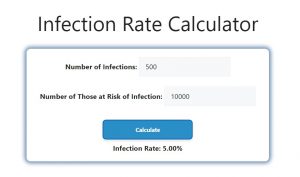About Infection Rate Calculator (Formula)
An Infection Rate Calculator is a vital tool in epidemiology and public health for measuring the proportion of people who have been infected with a disease out of a population at risk. This metric is crucial in tracking the spread of contagious diseases, making informed decisions on public health policies, and understanding the dynamics of disease transmission in various settings.
Formula
The formula used to calculate the infection rate (IR) is:
Infection Rate (IR) = (Number of Infections / Number of Those at Risk of Infection) * 100
Where:
- Number of Infections (I): Total cases of infection.
- Number of Those at Risk of Infection (R): Total number of people who are susceptible to the infection.
How to Use
To use the Infection Rate Calculator, follow these steps:
- Determine the Number of Infections (I): Identify how many individuals have contracted the disease.
- Identify Those at Risk (R): Determine the number of individuals in the population who are at risk of infection, excluding those who are immune or already infected.
- Apply the Formula: Divide the number of infections by the population at risk and multiply the result by 100 to express it as a percentage.
Example
Let’s say there is a community of 10,000 people, and 500 individuals have been infected by a virus. To calculate the infection rate:
- Number of Infections (I): 500
- Population at Risk (R): 10,000
Using the formula:
IR = (500 / 10,000) * 100
IR = 0.05 * 100
IR = 5%
In this case, the infection rate is 5%, meaning 5 out of every 100 people in the community have been infected.

FAQs
- What is an infection rate?
The infection rate is the percentage of people in a population who have contracted a specific disease. - Why is calculating infection rates important?
It helps public health officials track the spread of diseases, assess the effectiveness of interventions, and plan responses to outbreaks. - What is the difference between infection rate and transmission rate?
Infection rate refers to the proportion of infected individuals in a population, while transmission rate measures how easily a disease spreads from person to person. - How do you calculate infection rates for different regions?
For different regions, the infection rate is calculated by dividing the number of infections in that specific region by the population at risk in that region. - What does a higher infection rate indicate?
A higher infection rate indicates a larger proportion of the population has been infected, which could signal a widespread outbreak or an ineffective containment strategy. - Can infection rates decrease over time?
Yes, infection rates can decrease as the disease is controlled through interventions, vaccination, or when people recover and become immune. - What factors influence infection rates?
Factors include the infectiousness of the disease, public health measures, population density, immunity levels, and behavioral factors like hygiene and social distancing. - How are infection rates used in managing epidemics?
Infection rates help determine the severity of an outbreak and guide decisions on resource allocation, such as medical supplies and hospital capacity. - Is the infection rate the same as the incidence rate?
No, the incidence rate refers to the number of new cases occurring in a specific period, while the infection rate measures the proportion of the population that has been infected. - Can infection rates be applied to non-communicable diseases?
Infection rates are primarily used for communicable diseases. Non-communicable diseases, such as cancer, are measured using different epidemiological metrics. - How is the infection rate different from the case fatality rate?
The infection rate measures the number of people infected, while the case fatality rate measures the percentage of infected people who die from the disease. - What is considered a low infection rate?
A low infection rate typically indicates that the spread of the disease is under control or that a limited proportion of the population has been infected. - How does vaccination affect infection rates?
Vaccination can significantly lower infection rates by increasing immunity in the population and reducing the number of people at risk of infection. - Can the infection rate be over 100%?
No, the infection rate is expressed as a percentage and cannot exceed 100%, as it represents the proportion of infected individuals in the population. - What happens if the infection rate reaches 100%?
A 100% infection rate means that every person in the population at risk has been infected. - How do public health interventions impact infection rates?
Interventions like quarantine, social distancing, vaccination, and public awareness campaigns can significantly reduce infection rates. - What is the role of infection rates in forecasting disease spread?
Infection rates are used in mathematical models to predict the future spread of diseases and the potential impact on healthcare systems. - How do age groups affect infection rates?
Infection rates can vary by age group due to differences in susceptibility, behavior, and immunity. For example, children or the elderly may be more susceptible to certain diseases. - What tools are available for calculating infection rates?
Tools like online calculators, epidemiological software, and statistical models help calculate and project infection rates in different populations. - Can infection rates differ between urban and rural areas?
Yes, urban areas may have higher infection rates due to higher population density and increased contact, while rural areas may see lower rates but face challenges in healthcare access.
Conclusion
The Infection Rate Calculator is an essential tool for understanding the spread of infectious diseases within a population. By calculating the proportion of people infected compared to those at risk, public health professionals can assess the severity of outbreaks and make informed decisions on containment and prevention strategies. Understanding infection rates helps in tracking disease progression and responding effectively to prevent further spread.